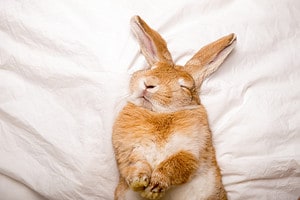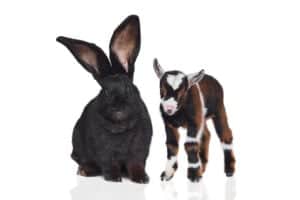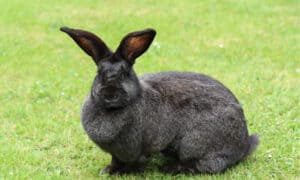Lionhead rabbits are one of the smallest and fluffiest rabbits you can keep as a pet. But have you ever wondered how big lionhead rabbits can get and how they compare to other breeds?
Lionhead rabbits are one of the smaller breeds. Most individuals only grow to about 8-10 inches long as adults. They are also very light, only weighing between 2.5-3.75 pounds.
Lionhead rabbits also have short ears relative to their body size. Their ears typically only grow to about 2-3.5 inches long.
What is a Lionhead Rabbit?
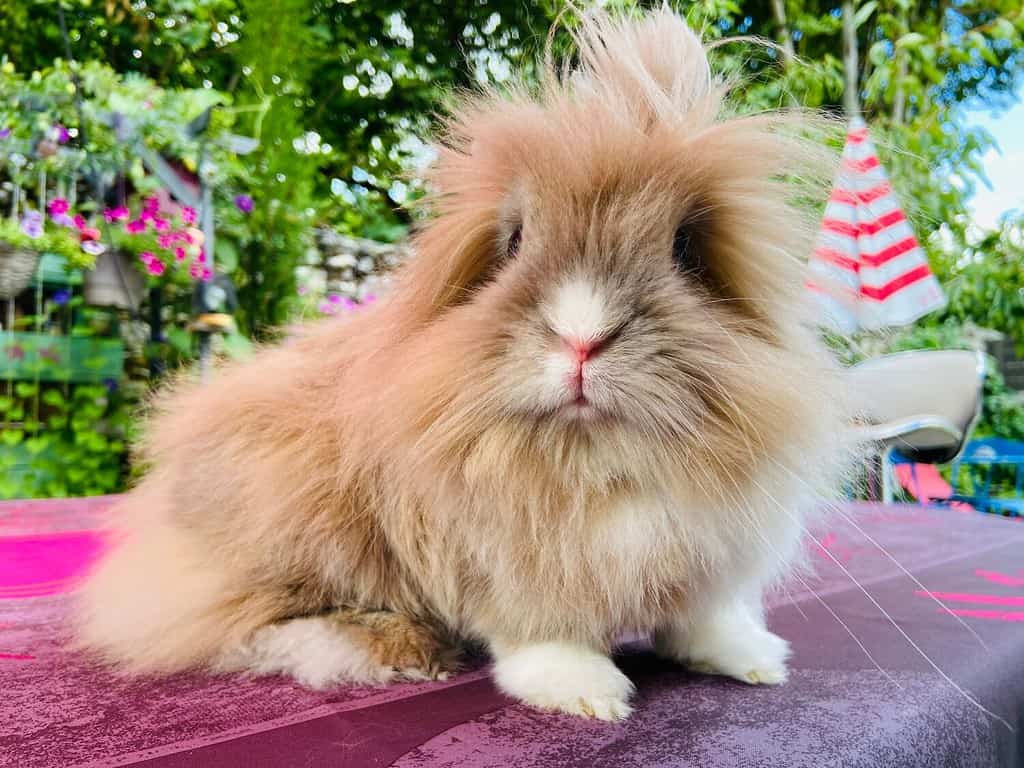
Their giant manes make lionhead rabbits look bigger than they really are.
©KanphotoSS/Shutterstock.com
Lionhead rabbits are one of the smallest rabbit breeds with small ears to match. Their compact bodies are covered in long fur. Thick manes around their heads make them resemble lions.
These tiny rabbits make great pets. They are friendly, docile, and cuddlier than other breeds.
Keep in mind that they need lots of room to roam, other rabbits to play with, and plenty of grooming!
Why Do Lionhead Rabbits Look Bigger Than They Are?
Although these rabbits are small, they sometimes seem larger than they really are because of all their fur. They get their name “lionhead” because of their long, thick mane of fur.
Lionheads need more frequent grooming than other rabbit breeds. Without that grooming, they are likely to get mats.
Brush their fur at least two to three times a week in the summer and winter.
They need daily brushing in the fall and spring when they are molting.
What Happens if You Don’t Brush all that Fur?
Their fur begins to die during molting, and if you don’t groom them, they will do it themselves. They are likely to ingest the dead fur. Excessive fur ingestion is dangerous.
Swallowing too much of their fur can cause an obstruction in the gastrointestinal (GI) tract. These obstructions can be fatal if not treated immediately because rabbits cannot vomit.
Surgery is necessary to save a lionhead rabbit from a furball obstruction. Fortunately, obstructions are easy to prevent with frequent grooming.
When Do Lionhead Rabbits Stop Growing?
Lionhead bunnies typically stop growing at about ten months of age.
What Determines the Size of a Lionhead Rabbit?
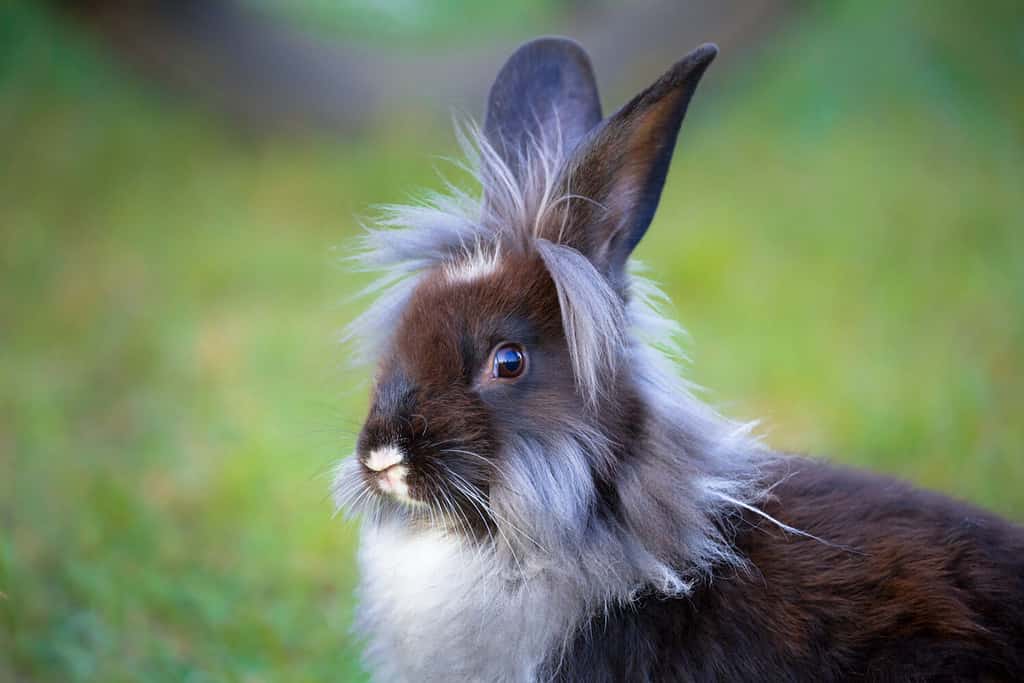
Lionhead rabbits only grow to about 8-10 inches long and weigh about 2.5-3.75 pounds.
©Katesalin Pagkaihang/Shutterstock.com
Genetics are the main factor in determining the size of a full-grown lionhead rabbit. A few outside characteristics may influence their size, like nutrition, sex, and overall health.
Baby lionhead rabbits living in poor conditions are likely to have stunted growth. Poor nutrition can also cause stunted growth. Stunted bunnies are unlikely to grow to the size they are supposed to be.
Male rabbits tend to be slightly larger than female rabbits, though this isn’t always the case. This is typical of most rabbit species and is not unique to lionheads.
The size of a lionhead rabbit is also influenced by the parent’s size. Larger parents are more likely to give birth to larger babies, and vice versa.
When Do Lionhead Rabbits Get Their Big Manes?
There are two different kinds of lionhead rabbits: double-mane and single-mane lionheads.
Double-mane lionheads have their manes at birth. As babies, you can tell where their mane will grow in. There is a distinctive “V” shape on their flanks made by their growing fur.
Single-mane lionheads don’t have their manes when they are born. Their manes grow in as they age.
How Big Are Lionhead Rabbits Compared to Other Rabbits?
Lionhead rabbits are smaller than other domestic bunnies, including English lops, standard rex, and Angora rabbits.
According to Walkerville Vet, there are over 70 breeds of domestic rabbits. Below are more than 40 rabbit breeds and their average sizes.
| Type of Rabbit | Weight |
|---|---|
| Lionhead | 2.5-3.75 pounds |
| Dwarf Lop | 4.2-5.3 pounds |
| Mini Lop | 3.3 pounds |
| Mini Rex | 3.7-4.4 pounds |
| Netherland Dwarf | <2.4 pounds |
| Standard Rex | 6-7.9 pounds |
| Dutch | 3.5-5.1 pounds |
| European Brown Rabbit | 4.4-5.5 pounds |
| New Zealand | 9-12 pounds |
| Flemish Giant | 13.2-22 pounds |
| Alaskan | 6-8.5 pounds |
| American | 9-12 pounds |
| American Chinchilla Rabbit | 9-12 pounds |
| American Sable | 7-12 pounds |
| English Angora | 5-7 pounds |
| French Angora | 7.5-10.5 pounds |
| Giant Angora | >8.5 pounds |
| Satin Angora | 6.5-9.5 pounds |
| Chinchilla Rabbit | 5.5-6.5 pounds |
| Creme d’Argent | 8-11 pounds |
| Argente | 5-12 pounds |
| Californian | 8-12 pounds |
| English Lop | >9 pounds |
| Belgian Hare | 6-9.5 pounds |
| Cinnamon | 8.5-11 pounds |
| Continental | >12.4 pounds |
| Checkered Giant | >11 pounds |
| Blanc de Hotot | 8-11 pounds |
| Dward Hotot | <3 pounds |
| Britannia Petite | <2.5 pounds |
| English Spot | 5-8 pounds |
| French Lop | >10 pounds |
| Florida White | 4-6 pounds |
| Giant Papillon | 13-14 pounds |
| Polish | <3.5 pounds |
| Havana | 4.5-6.5 pounds |
| Holland Lop | <4 pounds |
| Himalayan | 2.5-4.5 pounds |
| Jersey Woolly | <3.5 pounds |
| Harlequin | 6.5-9.5 pounds |
| Palomino | <9.5 pounds |
| Rex | 7.5-10.5 pounds |
| Silver Fox | 9-12 pounds |
| Lilac | 5.5-8 pounds |
| Satin | 8.5-11 pounds |
| Rhinelander | 6.5-10 pounds |
| Silver Marten | 6-9.5 pounds |
| Standard Chinchilla Rabbit | 5-7.5 pounds |
| Silver | 4-7 pounds |
| Tan | 4-6 pounds |
The photo featured at the top of this post is © HutchRock / Creative Commons – License / Original
Thank you for reading! Have some feedback for us? Contact the AZ Animals editorial team.



